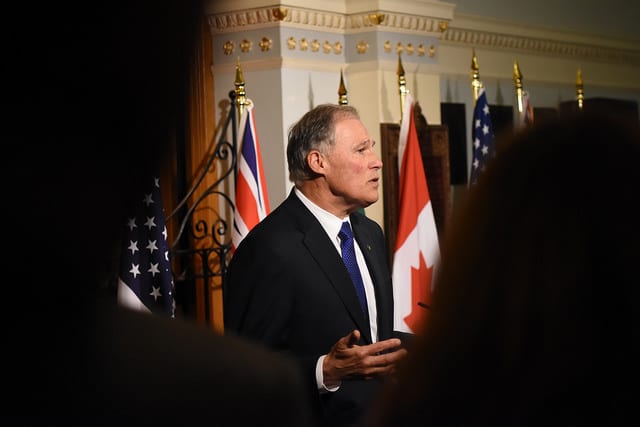Over the past three months, Washington has been on the forefront of state level carbon pricing legislation. Governor Jay Inslee announced in his 2018 State of the State address that he intended to work closely with the legislature to pass carbon pricing in the form of SB 6203. The bill was amended as it passed through various committees and prompted some big names to show up in Olympia in support of the Governor’s policy. Ultimately, the bill was pulled from the Senate floor when it became clear that it would be short “one or two votes.”

SB 6203 did not find its way to Washington Governor Jay Inslee’s desk. Photo: Official Governor’s Office Photo / Flickr
Does this mean Washington is down for the count? Absolutely not.


The Alliance for Justice and Clean Energy (AJCE) has been building a coalition and slowly preparing for a ballot initiative to put a fee on pollution in Washington for the past three years. Recently, they have been working quietly behind the scenes in preparation for the possibility that Inslee’s bill might not become law. The day following the defeat of SB 6203, AJCE announced that they had filed a ballot initiative called the “Protect Washington Act” for the November 2018 election. This ballot initiative, I-1631, is the latest attempt to pass carbon pricing in Washington and the second effort to hit the ballot.
What will the ballot initiative do if ratified by the people of Washington?
I-1631 creates a fee on pollution and directs generated revenue towards the “…purchase of pollution reduction and the protection of Washington’s clean air, clean water, healthy forests, and healthy communities.” The fee starts at $15/ton and increases annually by $2 plus inflation with no cap. The fee will continue to increase “until the state’s 2035 GHG reduction goal is met and the state’s emissions are on a trajectory that indicates that compliance with the state’s 2050 goal is likely.”
The initiative addresses the threat of climate change in Washington by designating three priority investment areas. 70% of revenue is directed towards GHG emissions reductions, 25% to environmental projects benefiting waterways and forests, and 5% to communities disproportionately affected by climate change in Washington.
I-1631 is written in a way that addresses the concerns of climate hawks, environmental justice advocates, environmentalists, labor advocates, economists, tribal leaders, and a large swath of Washington-based organizations that support carbon pricing as a mechanism to reduce GHG emissions. AJCE worked with these groups throughout coalition-building process and into the creation of investment priorities. The initiative continues this inclusive process by creating advisory panels, which allow stakeholders to be involved in the final implementation of investments.
The initiative also includes language to satisfy critics of the fee. It includes an exemption when fuels are used for agricultural purposes. Agricultural industries will also be able to seek funding to cover their transition from GHG-emitting machinery to alternatives driven by clean energy. There are also exemptions for airline fuel, coal facilities scheduled to shut down before 2025 (only one in the state), and businesses that would be at a competitive disadvantage relative to firms from neighboring states without carbon fees in place. These “Energy-intensive and trade-exposed sectors” (EITEs) cover 23 NAICS codes as designated by the Definitions Section of the Clean Air Rule. This could be a cause for concern for climate hawks, but AJCE calculates that the businesses that fall into these 23 codes account for only “8% of the state’s emissions.”
It is clear that the Protect Washington Act is a well thought-out ballot initiative that has been painstakingly crafted over several years. The next battle for the initiative will be getting it on the ballot. AJCE has until June to collect a little over a quarter million signatures, which is no small task for the coalition. As stated in an AJCE’s policy FAQ, “in order to accomplish this, we will need to build a massive volunteer army – to collect signatures, educate and turnout voters.”
Are you interested in volunteering with AJCE or signing on to the initiative? Check out their volunteer form here and their signature gathering events here!
You can find the full bill text here.
See a more detailed breakdown of the initiative below:
Investment:
The initiative primarily mitigates the effects of climate change on the people, businesses, and environment of Washington through investment. The policy designates a number of funding categories in sections 3-7 that outline the scope of the intended impact of the the initiative.

Fee on Pollution
This fee on pollution has two effects. It primarily generates revenue for the aforementioned programs. It also serves as a price signal to the energy market to incentivize demand reduction for relatively polluting energy sources. For example, natural gas facilities would be incentivized to shift towards renewable energy sources and motorists would be incentivized to shift towards electric vehicles.

Implementation and Evaluation
Sections 10-13 of the initiative outline how AJCE plans to implement the investments, include coalition stakeholders in the investment decision making process, and evaluate the effectiveness of the programs resulting from the investments.










